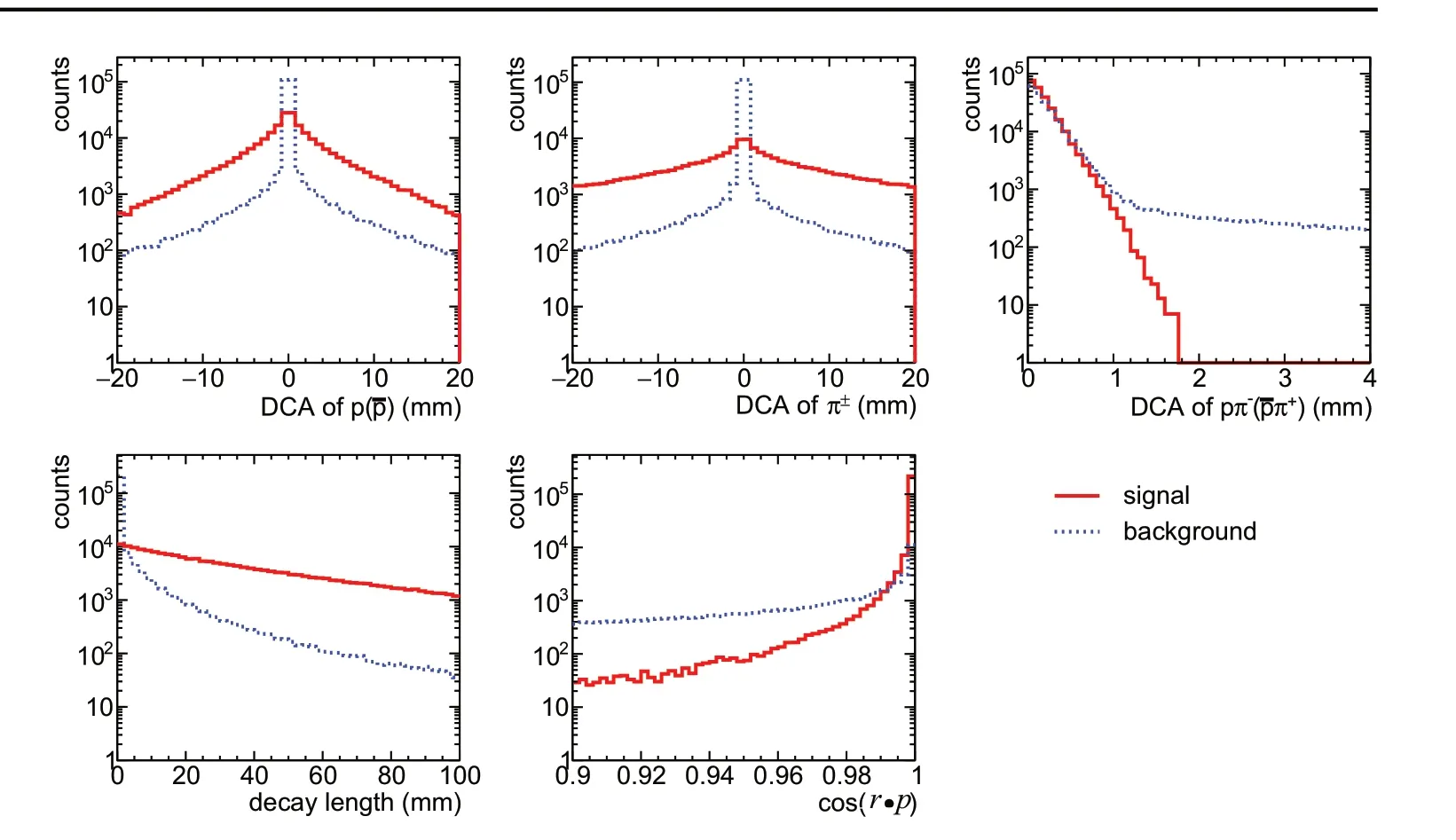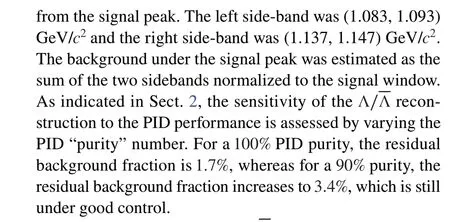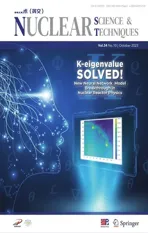Lambda polarization at the Electron‑ion collider in China
2023-12-05ZhaohuiziJiXiaoYanZhaoAiQiangGuoQingHuaXuJinLongZhang
Zhaohuizi Ji · Xiao‑Yan Zhao · Ai‑Qiang Guo · Qing‑Hua Xu · Jin‑Long Zhang,3
Abstract Lambda polarization can be measured through its self-analyzing weak decay, making it an ideal candidate for studying spin effects in high-energy scattering.In lepton-nucleon deep inelastic scattering (DIS), Lambda polarization measurements can probe polarized parton distribution functions (PDFs) and polarized fragmentation functions (FFs).One of the most promising facilities for high-energy nuclear physics research is the proposed Electron-ion collider in China (EicC).As a next-generation facility, EicC is set to advance our understanding of nuclear physics to new heights.In this article, we study the Lambda production in electron-proton collisions at the EicC energy, in particular the reconstruction of Lambda based on the performance of the designed EicC detector.In addition, taking spontaneous transverse polarization as an example,we provide a theoretical prediction with a statistical projection based on one month of EicC data, offering valuable insights into future research prospects.
Keywords Electron-ion collider in China · Lambda polarization · Polarizing fragmentation functions · Nucleon structure
1 Introduction
Spin is a fundamental particle property that plays a critical role in the advancement of modern physics.A growing number of experimental findings, such as the spontaneous transverse polarization of Λ and the proton spin crisis, have demonstrated that there is significantly more to be understood about spin behavior in high-energy reactions.The Lambda hyperon ( Λ∕Λ ) has emerged as an exceptionally powerful tool in spin physics, primarily owing to its parity-violating weak decay, which results in a nonuniform angular distribution of its products with respect to the Λ(Λ)spin direction [1].In high-energy reactions, Λ(Λ) is abundantly produced and efficiently detected via the decay channel Λ →pπ-(Λ →p¯π+) (branching ratio is 63.9% ).In the Λ(Λ) rest frame, the decay protons are preferentially emitted along the polarization direction of their parent Λ with the following angular distribution:

The spontaneous transverse polarization of Λ was first observed in 1976 in the unpolarized proton beam scattering on a beryllium target [3], where perturbative Quantum Chromodynamics (QCD) only predicted a negligible polarization [4].These puzzling results triggered a series of theoretical and phenomenological studies that extended far beyond Λ polarization.Experimentally, measurements of Λ(Λ) polarization have since been extensively explored in various high-energy processes, including electron-positron annihilation [5–7], lepton-nucleon deeply inelastic scattering (DIS) [8–10], hadron-hadron scattering [11–13], and heavy ion collisions [14–18], yielding invaluable insights into numerous aspects of physics.These measurements have served diverse purposes, including unraveling the physical origins of spontaneous polarization, understanding the nucleon spin structure, comprehending spin effects in the fragmentation processes, and exploring extreme conditions of high density and high temperature in heavy-ion collisions.
High-precision Λ(Λ) polarization measurements in the proposed electron-ion collider provide unique opportunities to study spin-dependent fragmentation functions (FFs)and polarized parton distribution functions (PDFs) [19–26].The Electron-ion collider in China, EicC, is the proposed next-generation high-energy nuclear physics facility based on the High Intensity heavy-ion Accelerator Facility (HIAF)in Huizhou, China [27, 28].It is conceptually designed to deliver high luminosity electron-proton, electron-ion collisions with highly polarized electron, proton, and light-ion beams.With a complementary kinematics coverage to other electron-ion collider proposals worldwide [29–31], the featured physics at the EicC includes a 3-dimensional proton spin structure, nuclear partonic structure, and exotic hadron states,etc..Λ(Λ) polarization measurements at the EicC are expected to be sensitive not only to spin-dependent parton distribution functions but also to spin-dependent fragmentation functions.Potential measurements of the Λ(Λ) transverse polarization and impact studies have been performed for the US-based EIC, which are designed to collide with electron and proton/ion beams at significantly higher energies than EicC [26].
In this article, the Λ(Λ) production in electron-proton scattering under the EicC configuration was studied.Based on the current conceptual EicC detector design, especially that of the tracking subsystem, the reconstruction performance for Λ∕Λ is assessed.In Sect.2, the simulation setup including the event generator used is described, as well as the detector configuration and corresponding fast simulation procedure.The performance of the Λ∕Λ reconstruction is presented in Sect.3.In Sect.4, considering the spontaneous transverse polarization as an example, the potential statistical precision for the polarization measurements is presented along with the theoretical predictions.A brief summary and outlook are provided in Sect.5.
2 Simulation framework
To simulate the Λ(Λ) production in electron-proton scattering, the event generator PYTHIAeRHIC [32], a modified version of PYTHIA6.4.28 [33], was used with the parton distribution functions (PDFs) input from LHAPDF [34].The collision energy chosen was the baseline energy outlined in the EicC whitepaper [28], which was a 3.5 GeV electron on a 20 GeV proton.The leading-order diagram for the Λ production in the DIS process is shown in Fig.1.The kinematics of the studied DIS events were constrained to the following ranges: Bjorken-x10-3

Fig.1 Leading-order diagram for Λ production in a semi-inclusive DIS process
At the generator level, the average number of Λ produced per DIS event in the kinematic range indicated above was approximately 0.1.In the laboratory frame, the momentum and polar angle distributions for Λ and the decay products are shown in Fig.2.Comparing the distributions of the daughter proton and pion with Λ , protons are found to carry most of the Λ momentum whereas pions only share a small fraction.Λ is preferentially produced in the proton-going direction, with a large amount produced at a significantly forward angle.The same distributions shown in Fig.2 for Λ are similar with slight differences, which are discussed later.

Fig.2 (Color online) Momentum (radial) and polar angle (polar) distributions for Λ and its decay products in the laboratory frame

Fig.3 (Color online) Upper panels: Feynman-x xF versus The pseudorapidity η for Λ (left)and Λ (right) in the laboratory frame.Only Λ∕Λ above the red line ( xF >0 ) are retained.Lower panels: transverse momentum pT versus the pseudorapdity η for Λ (left) and Λ(right) with xF >0 and<3(also<3 for the daughter proton and pion)

The preliminary conceptual design of the EicC detector has been described in white papers [27, 28].From the inner to outer parts, it consists of a vertex/tracking detector,particle identification (PID) system, and calorimeter system,etc..For the Λ measurement, the most relevant parts were the tracking and PID systems.The latest EicC tracking detector design is described in Ref.[35].Current tracking system designs use hybrid models.For the middle rapidity(<1.1 ), there are 5 layers of silicon and 4 layers of micropattern gaseous detectors (MPGD), radially ranging from 3.3 cm to 77.5 cm.For>1.1 , the tracking system consists of silicon disks followed by a large-area micromegas in the forward (proton/nucleus going) direction and all silicon disks in the backward (electron-going) direction.For the PID system,a time-of-flight detector and Cherenkov detector were used for particle identification at the middle and forward rapidity,respectively.

Fig.4 (Color online) Origins of Λ andΛ with xF >0 , <3 based on the PYTHIA event record
For the tracking system, a full GEANT4 simulation was performed with the latest design based on which the resolutions for the primary vertex position, distances from the tracks-to-tracks and from tracks-to-points, and track momentum, the tracking detector efficiencies are provided as a function of trackspTandηin Ref.[35] (Fig.4-9).In addition, a fast simulation framework was developed to simulate the detector responses learned from the GEANT4-base simulation.In this study, we followed the same fast simulation procedure described in Ref.[35].A detailed GEANT4 simulation of the PID system was not available when this study was performed.To mimic the particle identification imperfection, a simplified “PID smearing” is included in the detector effect fast simulation.In principle, the PID effi-ciency correlates with the momentum of the particles.However, we employed a toy model to study the PID effect with a typical PID efficiency of 95% as follows.The identifiedπ,K,orphave a 95% possibility of being correct and a 2.5% possibility of being one of the other two particles, respectively,as described by the following matrix:
Here, 95% of the PID purity is specifically chosen, and a few other numbers are also checked for a complete study.
3 Lambda reconstruction

Fig.5 Topology schematic diagram of the Λ production and its decay process through Λ →pπ-
Similar to the method used in other experiments with a tracking detector, Λ∕Λ reconstruction in this study was based on the topological structure of the decay channel with a large branching ratio, Λ →pπ-andΛ →pπ+.Considering Λ as an example, Fig.5 presents a schematic of the main topological features of its production and decay processes in a tracking detector.The blue dot at the bottom-left represents theepscattering vertex, which is called the “primary vertex”.Λ∕Λ is emitted from the primary vertex, which then moves along the straight magenta dashed-line and decay at the “V0 vertex”.The decay productspπ-(pπ+) travel along the helical lines with opposite bending directions in the magnetic field.
The reconstruction of Λ/Λ starts by pairing the proton and pion tracks with opposite charges.To select the Λ/Λ candidates and suppress random backgrounds, the following selection variables were considered:
(1) The distance of closest approach (DCA) of the proton and pion tracks to the primary vertex.As indicated in Fig.5, DCApand DCAπfrom the signals should be significantly higher than those from the background because the parent Λ/Λ flies at certain distances from the primary vertex before its decay.
(2) The DCA between paired proton and pion tracks.For the Λ/Λ signal, this variable should be consistent with zero within the track space resolution.The decay point(V0 vertex) is the midpoint of these two tracks in the closest approach, as indicated by the brown triangle in Fig.5.
(3) The decay length of Λ∕Λ candidates, which is the distance between the primary vertex and the V0 vertex.The characteristic decay length of Λ hyperoncτis 7.89 cm [2].
(4) The angle between the Λ∕Λ candidate momentump→and its trajectory→rfrom the primary vertex.For the Λ∕Λ directly produced from the primary vertex, the momentum direction is supposed to be along its trajectory from the primary vertex.Correspondingly,cos(→r⋅p→) should be significantly close to one.

Fig.6 (Color online) Distributions of the topological variables for the Λ∕Λ signal(red) and background (blue),respectively

Table 1 Summary of the topological criteria for Λ∕Λ reconstruction

Fig.8 (Color online) Reconstruction efficiency of Λ and Λ as a function of pT after all the selection criteria were applied

Fig.7 (Color online) Invariant mass distributions of the Λ andΛ candidates passing all the selection criteria
To determine the selection criteria quantitatively, the distributions of the proton-pion pairs from pure Λ∕Λ samples were compared with the proton-pion pairs from the background, which are shown in Fig.6.Based on the comparisons, a set of selection criteria was optimized to balance the background fraction and the Λ∕Λ reconstruction efficiency to retain as many signals as possible while maintaining the background fraction at a relatively low level.The numerical cutting conditions are presented in Table 1.



Figure 8 presents the Λ and Λ reconstruction efficiencies versus the transverse momentum.The reconstruction efficiency involves several effects, including the topological cuts, detector acceptance, and track efficiency, which depend on trackpTand trackη.For Λ∕Λ with a large decay length,the number of tracking detector layers through which the daughter tracks pass decreases, as does the tracking effi-ciency.The efficiency at a significantly lowpTis limited by the detector acceptance owing to the magnetic field.Owing to low transverse momentum in the forward region (large), the efficiency decreases significantly.As already shown in Fig.3, more Λ than Λ are produced at a large pseudorapidity where the reconstruction efficiency is low, which leads to a significantly higher efficiency of Λ compared Λ topT>0.5 GeV/c.WhenpTis larger than 2 GeV/c, the efficiency of Λ reconstruction increases and approaches Λ because Λ at the middle rapidity starts to dominate its production.
4 Spontaneous transverse polarization
In this section, we take the Λ∕Λ spontaneous transverse polarization as an example to explore the physics potential of EicC.The theoretical calculations and statistical projections based on our simulation results are as follows.
The QCD formalism is used to describe Λ spontaneous transverse polarizationPΛin the semi- inclusive DIS process,e-(l)+p(P)-→e-(l′)+Λ(pΛ,SΛ⊥)+X.The Trento convention [36] is followed in the calculation, where the virtual photon moves in the positivezdirection and the proton moves in the negativezdirection, and the differential cross-section can be expressed as follows [37, 38]:

wherep⊥andk⊥denote the transverse momentum of the quark relative to the initial proton and the transverse momentum of Λ relative to its parent quark, respectively.




Fig.9 Statistical projection with the theoretical predictions for the Λ andΛ polarization in the ep collisions at EicC.The projected statistical errors are smaller than those of the marker, and are thus invisible
The TMDs were parameterized using the typical Gaussian form as the product of the collinear functions and Gaussian widths:isospin symmetry, and CKT, which allows isospin symmetry violations [40].Future EicC will provide an ideal place to test the Λ isospin symmetry of FFs.In our study, we employed these different parameterizations to calculate and compare the polarization observables.
Using the parameterizations for the TMDs in Eq.(6), the spontaneous transverse polarization of Λ in Eq.(4) can be expressed in the following analytical form:
Using this expression, we can estimate the magnitude ofPΛin SIDIS.ConsideringQ2=5 GeV2,PΛis plotted as a function ofpΛ⊥in Fig.9.The results were obtained for different values covered by the kinematic range of the future EicC.To obtain thePΛdependence on the Feynman variablexF,xFwas parameterized as a function of the Lorentz-invariant variables (xB,zΛ,Q) through a kinematic transformation as follows:

5 Summary and outlook
EicC is the proposed next-generation nuclear physics facility, which is expected to provide unique opportunities for precisely studying the 3-dimensional nucleon structure,nuclear partonic structures, and exotic hadron states,etc.The Lambda hyperon, which serves as a natural final state polarimeter, is a powerful tool for studying the nucleon spin structure and spin effect in the fragmentation process.The Λ(Λ) measurements at EicC are of special importance and interest.
Based on the conceptual design of the EicC tracking system and GEANT4 simulation, we performed a detailed study of Λ(Λ) production and reconstruction.In addition, taking spontaneous transverse polarization as an example, theoretical predictions were provided as functions of different kinematic variables, along with the statistical projections with one month of data obtained at EicC.We found that measurements using the EicC data obtained for only one month of operation based on the current accelerator design could provide distinguishable constraints for different parameterizations of the fragmentation functions.
EicC is designed to have both beams polarized, and the Λ(Λ) polarization transferred either from the lepton or the proton beam can provide important constraints on the spin-dependent PDFs and FFs in both co-linear and transverse momentum-dependent frameworks.More observables will be studied in the future, where decay contributions from heavier particles and a more realistic PID can be further investigated.
AcknowledgementsWe thank Tian-Bo Liu for the valuable discussions on the theoretical calculations.We thank the EicC tracking and heavy flavor working groups for their technical support with the detector simulation and useful suggestions on the analyses.
Author contributionsAll authors contributed to the study conception and design.Material preparation, data collection and analysis were performed by Zhaohuizi Ji, Xiao-Yan Zhao, Ai-Qiang Guo, Qing-Hua Xu,and Jin-Long Zhang.The first draft of the manuscript was written by Zhaohuizi Ji and Xiao-Yan Zhao and all authors commented on previous versions of the manuscript.All authors read and approved the final manuscript.
Data availabilityThe data that support the findings of this study are openly available in Science Data Bank at https://www.doi.org/10.57760/sciencedb.j00186.00271 and https://cstr.cn/31253.11.sciencedb.j00186.00271.
Declaration
Conflict of interestThe authors declare that they have no competing interests.
杂志排行
Nuclear Science and Techniques的其它文章
- Applying the Kalman filter particle method to strange and open charm hadron reconstruction in the STAR experiment
- Novel algorithm for detection and identification of radioactive materials in an urban environment
- Measurements of absolute electron capture cross sections in He2+–He and Ne8+–O2, N2, CH4 collisions
- CFD analysis of a CiADS fuel assembly during the steam generator tube rupture accident based on the LBEsteamEulerFoam
- Production of neutron‑rich actinide isotopes in isobaric collisions via multinucleon transfer reactions
- Physics-constrained neural network for solving discontinuous interface K-eigenvalue problem with application to reactor physics
